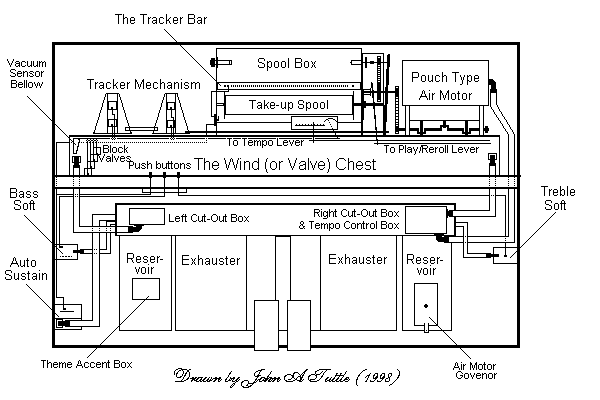I found this sort of fascinating, so I thought I'd see what else I could learn about player pianos.
- Another word for player pianos is "pianola," which was at first a trademarked term, but then it became the word for all player pianos (the same way people use the word "Kleenex" to refer to all disposable tissues, or people in the South say "Coke" to mean any soda).
- You can, of course, let the roll and piano go by themselves...

(Ad posted at Player Piano Rebirth)
- ... but with an operator or "pianolist" at the controls, he or she can make subtle improvements to the sound.
- Pressing on the foot pedals makes the thing go, but if you vary the pressure, you can change the tone. Manipulating the levers located under the front of the keyboard can change the tempo, accentuate particular notes, or sustain other notes. These controls also allow the pianolist to rewind and re-play the roll.
- The keys can also be played the same way a conventional piano is played. This means the operator can play the keys while a roll is playing, if desired, to create harmonies or other effects.
- Player pianos reached their peak of popularity between 1900 and 1930. Player pianos that exist today are around 70 years old and often need a lot of care and attention.
- Here's a scaled-down description of how a pianola works:
- Pianolist pumps air into the organ using the two foot pedals, which also makes the roll turn
- Perforations in the paper, each representing a note, are "read" by a pneumatic device, which makes a valve open
- The valve opening tells a pneumatic motor to go into action
- The motor triggers a wooden, felt-covered "finger," or hammer, which presses the corresponding key, from behind the scenes, of the keyboard.

Diagram of the inner workings of a player piano. A little more complex than a conventional piano.
(Diagram from Player-Care.com)
- The earliest pianola was made in 1895, by a guy named Edwin Votey, from Detroit. The early player pianos could only play about 60 notes. It wasn't until 1908 that they figured out how to get pianolas to be able to access all 88 keys of a typical piano.
- The barrel piano, or drum piano, that people played on the street was the early version of the player piano.

One type of barrel piano. Many of these were larger, more like the size of a popcorn cart, with handles like a wheelbarrow.
(Photo from the Player Piano Page)
- Player pianos died when the stock market crashed in 1929. Only a very few manufacturers survived that crash, but even so, most people couldn't afford to buy a player piano when they could barely find work.
- Player pianos enjoyed a slight revival in the 1960s, but it didn't last long. Currently, nobody makes any player pianos anymore.
- However, people are working on methods to preserve the music on the paper rolls, in electronic form. Most of this preserved music is in stored in midi files.
- I found a site where you can listen to some midi files of player piano songs, and I picked out one I liked, the Powder Rag & Live Wires Rag. Apparently, making things explode is fun!
- This music really is kind of happy, goofy, dancy. It's easy to understand, listening to it now, why it went out of fashion when the stock market crashed, and then World War II hit.
Sources
The Player Piano Page
Terry Smythe, Player Piano Rebirth
Listen to more player piano songs at Robert Perry's site (he's from New Zealand)
No comments:
Post a Comment
If you're a spammer, there's no point posting a comment. It will automatically get filtered out or deleted. Comments from real people, however, are always very welcome!